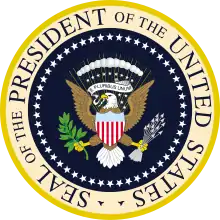Economic policy of the Joe Biden administration
The economic policy of the Joe Biden administration is predicted to be characterized by economic stimuli resulting from the economic impact of the COVID-19 pandemic, raising the minimum wage in the United States, investment in clean energy, expansion of access to affordable healthcare, and the forgiveness of student loans.
| ||
|---|---|---|
|
Incumbent
Vice President of the United States
Presidential campaigns
Vice presidential campaigns Published works
 |
||
Overview
President Biden inherited a challenging economic and budgetary situation from President Trump, due significantly to the continuing COVID-19 pandemic. As of December 2020, the jobs level was nearly 10 million (6%) below the early 2020 peak, and the unemployment rate was an elevated 6.7%.[1] There was a record budget deficit in fiscal year 2020 of $3.1 trillion, or 14.9% GDP.[2]
Pandemic response
Biden proposed a $1.9 trillion relief package called the American Rescue Plan in January 2021. The New York Times reported that key elements of the plan include:
- Extending expanded unemployment benefits with a $400 weekly supplement through end of September (vs. March 31 currently)
- $1,400 direct payments to individuals ("checks");
- $20 billion for a national vaccine program, including preparation of community vaccination centers;
- Raising minimum wage to $15/hour;
- Funding for 100,000 public health workers for vaccination outreach and contact tracing;
- Funding to help address disproportionate impact on people of color, for community health centers, prisons, and jails;
- Emergency paid leave for over 100 million Americans;
- Tax credits for families to offset up to $8,000 in annual child care costs;
- Aid to renters with unpaid debts to landlords;
- Grants to small businesses;
- Funds to accelerate vaccine deployment and to safely reopen most schools within 100 days; and
- $350 billion to help state and local governments bridge budget shortfalls.[3]
Executive orders
January 2021
On January 22, President Biden issued an executive order intended to deliver economic relief to families and businesses. This included:
- Increasing access to food for students missing meals due to school closures and enhancing SNAP (food stamps) benefits;
- Improving delivery of direct stimulus payments;
- Request Department of Labor to clarify that workers can still access unemployment insurance if employment would have jeopardized their health due to COVID-19;
- Develop support network to help families and businesses access government benefits; and
- Require federal contractors to pay $15 minimum wage.[4]
Minimum wage
Biden's American Rescue Plan included raising the minimum wage to $15 per hour. A CBO study in 2019 estimated that raising the minimum wage to $15 by 2025 would increase wages for 17 million directly in that year, although the number of persons with jobs could be reduced in a range of zero to 3.7 million.[5]
Education
Biden has proposed paying for college tuition and pre-K for middle-class families. He also wants to forgive some or all of student loans.[6]
Student loan forgiveness
Biden supported canceling student loan debt up to $10,000 during 2020, for some borrowers. Other prominent Democrats (Senators Warren and Schumer) co-authored a resolution including cancelations up to $50,000 for all borrowers. There is an active debate about whether legislation or executive order is sufficient to cancel student loans. Critics argued that canceling student loans is regressive rather than progressive, as most with student loans are college educated and earn more. Further, the impact on college tuition pricing and access is unclear.[7]
The Federal Reserve Bank of New York reported that student loans totaled $1.5 trillion in 2019, with 43 million borrowers. The average balance was $33,500. About 14 million borrowers (33%) had balances below $10,000; 20 million (47%) had balances $10,000-$50,000, and 9 million (20%) had balances over $50,000.[8]
The Committee for a Responsible Federal Budget reported in November 2020 that canceling student loans had several pros and cons, but was a relatively ineffective economic stimulus. While household net worth would rise by $1.5 trillion if all loans were canceled, in terms of monthly spending the typical household with student loan debt would be avoiding a $200–300 monthly payment. Re-directing this savings to other spending would have limited economic impact of about $100 billion/year. One important consideration is the tax treatment of the forgiven debt; if treated as a gain (income), it would likely be taxable in the absence of legislation negating the gain, offsetting the small positive economic impact.[9]
CNBC reported that forgiving $10,000 in student debt for all borrowers would cost the government $377 billion, but forgiving $10,000 just for those with debt below $10,000 (about a third of borrowers) would cost $75 billion. Debtors in the latter category tend to be those struggling to pay off their debt.[10]
Healthcare
Biden has proposed lowering the Medicare age to 60, and expanding the Affordable Care Act subsidies and eligibility.[6]
Lowering Medicare eligibility age
Biden has proposed lowering the Medicare eligibility from 65 years of age to 60. There are about 23 million persons age 60-64 who could directly benefit, either by paying lower insurance premiums or no longer needing to obtain their insurance through an employer. There are about 1.7 million in the 60-64 age range who are uninsured, and 3.2 million who buy coverage because they are not covered by an employer. Hospitals would receive lower reimbursement rates for age 60-64 patients that enroll in Medicare. This plan would also increase the budget deficit, although the CBO has not officially scored the proposal as of January 2021. Lowering the Medicare age is popular, with one poll indicating 85% of Democrats and 69% of Republicans support lowering the eligibility age to as young as 50.[11]
Cryptocurrency
President Biden froze all federal regulatory proposals, including former Treasury Secretary Steve Mnuchin's proposed rules on self-hosted crypto wallets, until his new administration can review them.[12] Biden asked his chief of staff, Ron Klaine, to communicate the order to all federal departments and agencies in a memorandum, Modernizing Regulatory Review, on January 20, 2021.[13] Except for emergency situations, any proposed rules were to be halted and any sent to the Office of the Federal Register should be immediately withdrawn.[13] Under Mnuchin, the U.S. Treasury announced proposed rules in December 2020 requiring registered crypto exchanges to verify the "identity of their customers, if a counterparty uses an unhosted or otherwise covered wallet and the transaction is greater than $3,000." [12]
Under the proposed rules, users of such crypto exchanges who wish to move their holdings into private, or self-hosted wallets, would be required to provide detailed personal information for transactions over $3,000.[12] These exchanges would also have to report transactions valued at more than $10,000 to the Financial Crimes Enforcement Network, or FinCEN. Critics pointed out that the proposed rules threaten crypto innovation and privacy rights of individuals and entities that transact in cryptocurrencies.[12]
During Janet Yellen's confirmation hearing before the Senate Finance Committee as Biden's choice for Secretary of the Treasury, Sen. Maggie Hassan (D-N.H.) asked Yellen about the use of cryptocurrency by terrorists and other criminals. "Cryptocurrencies are a particular concern," Yellen responded. "I think many are used—at least in a transactions sense—mainly for illicit financing." She said she wanted to "examine ways in which we can curtail their use and make sure that [money laundering] doesn't occur through those channels."[14]
Unions
Biden signed an executive order on January 22, 2021 that removed schedule F, overturning a number of Trump's policies that limited the collective bargaining power of federal unions.[15][16]
Taxation and deficits
Individual taxes
Biden has pledged to raise taxes only on individual persons earning over $200,000, or $400,000 for married couples filing jointly.[6] Treasury Secretary nominee Janet Yellen reiterated Biden's pledge in her answers during her Senate confirmation hearing process in January 2021.[17] The individual tax cuts in President Trump's Tax Cuts and Jobs Act are scheduled to expire after 2025, for all income levels. This means they automatically revert to the higher rates of the Obama Administration, in the absence of new legislation.
Corporate taxes
Biden has proposed raising the corporate tax rate from 21% to 28%.[6] This rate was lowered by President Trump's Tax Cuts and Jobs Act from 35% to 21%, so Biden's proposal represents a partial reversal. The lower corporate tax rate in Trump's tax cuts does not expire, in contrast to the individual rates, so legislation would be required to change it.
Budget deficit
There was record federal budget deficit in fiscal year 2020 of $3.1 trillion, or 14.9% GDP.[2] In September 2020, CBO projected the deficit would be $1.8 trillion in fiscal year 2021.[18] However, this was prior to the $2.3 trillion Consolidated Appropriations Act enacted on December 27, 2020 (including a $1.4 trillion omnibus spending bill and $900 billion relief package) and Biden's $1.9 trillion recovery proposal. The CBO Budget and Economic Outlook report (pending as of January 22, 2021) will provide a revised estimate.
Biden's plans to raise taxes on higher income persons and corporations are expected to only partially offset the increases in spending he proposes. A November 2020 analysis by the Tax Policy Center indicated his proposals would add $2.1 trillion to revenue over a decade.[19]
References
- "THE EMPLOYMENT SITUATION —DECEMBER 2020" (PDF). United States Department of Labor. January 8, 2021. Retrieved January 20, 2021.
- "Monthly Budget Review for September 2020". cbo.gov. September 2020. Retrieved January 22, 2021.
- Tankersley, Jim; Crowley, Michael (January 14, 2021). "Here are the highlights of Biden's $1.9 trillion 'American Rescue Plan.'". The New York Times. ISSN 0362-4331. Retrieved January 16, 2021.
- "Fact Sheet: President Biden's New Executive Actions Deliver Economic Relief for American Families and Businesses Amid the COVID-19 Crises". whitehouse.gov. January 22, 2021. Retrieved January 23, 2021.
- "The Effects on Employment and Family Income of Increasing the Federal Minimum Wage". cbo.gov. July 8, 2019. Retrieved January 22, 2021.
- "This is the future Joe Biden wants". Vox. August 17, 2020. Retrieved January 22, 2021.
- "Biden Wants To Help Pay Some Student Loans, But There's Pressure To Go Further". npr.org. November 17, 2020. Retrieved January 23, 2021.
- "Who Borrows for College—and Who Repays?". newyorkfed.org. October 9, 2019. Retrieved January 23, 2021.
- "Canceling Student Loan Debt Is Poor Economic Stimulus". crfb.org. November 2020. Retrieved January 23, 2021.
- "Experts weigh in on Biden's support of $10,000 in student debt forgiveness". cnbc.com. January 22, 2021. Retrieved January 24, 2021.
- "Biden Wants To Lower Medicare Eligibility Age To 60, But Hospitals Push Back". npr.org. November 11, 2021. Retrieved January 23, 2021.
- GmbH, finanzen net. "Biden freezes all federal regulatory proposals, including Mnuchin's controversial crypto wallet legislation, until his new administration can review them". markets.businessinsider.com. Retrieved January 24, 2021.
- "Regulatory Freeze Pending Review". The White House. January 20, 2021. Retrieved January 24, 2021.
- Lee, Timothy B. (January 20, 2021). "Treasury nominee Yellen is looking to curtail use of cryptocurrency". Ars Technica. Retrieved January 24, 2021.
- Wagner, Erich (January 22, 2021). "Biden to Sign Executive Order Killing Schedule F, Restoring Collective Bargaining Rights". Government Executive. Retrieved January 22, 2021.
- Ogrysko, Nicole (January 22, 2021). "Biden to repeal Schedule F, overturn Trump workforce policies with new executive order". Federal News Network. Retrieved January 22, 2021.
- "What Janet Yellen is saying about raising taxes on wealthy Americans—and other key issues—as Biden's Treasury Secretary-designate". fortune.com. January 21, 2021. Retrieved January 22, 2021.
- "An Update to the Budget Outlook: 2020 to 2030". cbo.gov. September 2020. Retrieved January 22, 2021.
- "An Updated Analysis of Former VP Biden's Tax Proposals". taxpolicycenter.org. November 6, 2020. Retrieved January 22, 2021.
External links
| Wikimedia Commons has media related to Economic policy of the Biden administration. |

